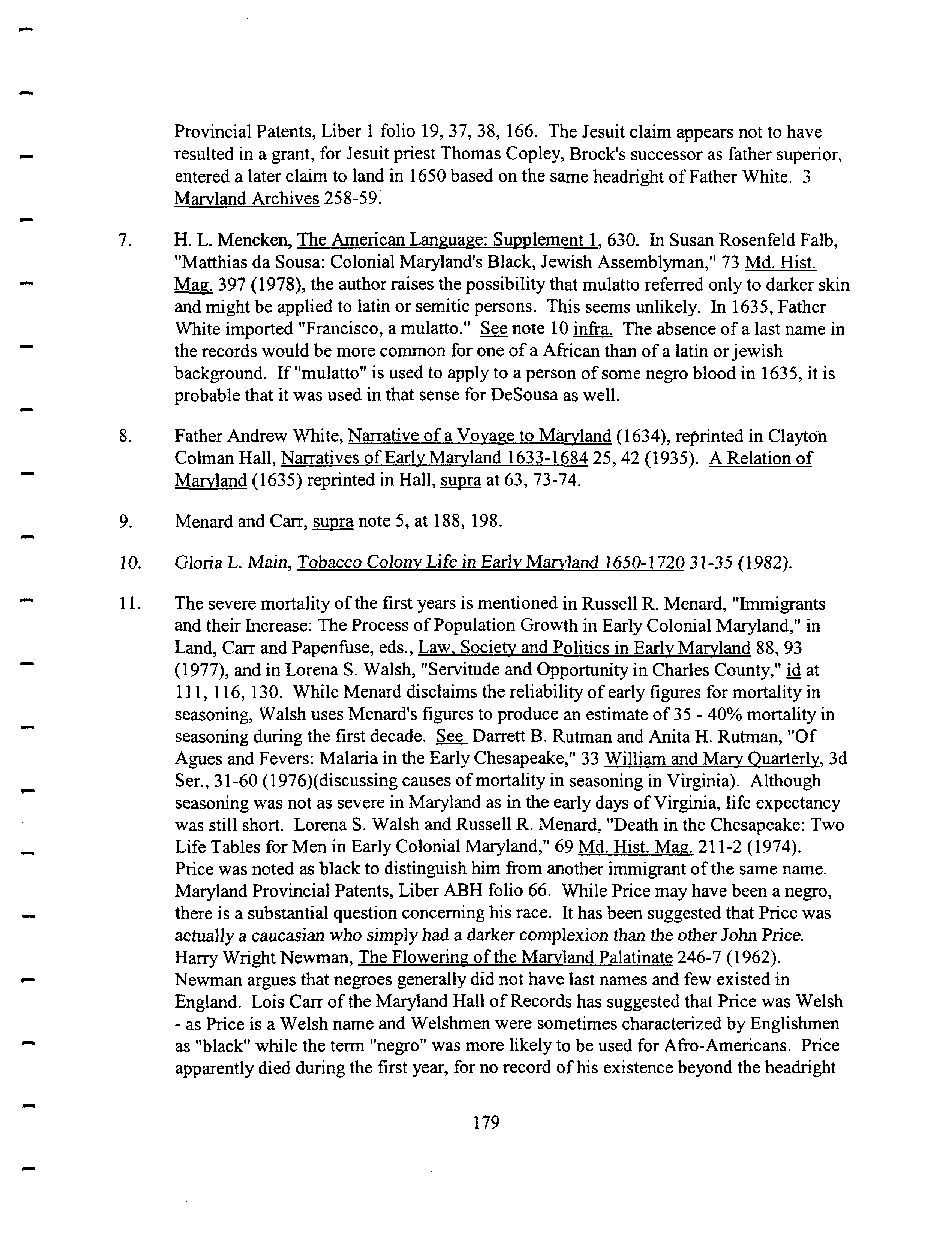|
Provincial Patents, Liber 1 folio 19, 37, 38, 166. The Jesuit claim appears not to have
resulted in a grant, for Jesuit priest Thomas Copley, Brock's successor as father superior,
entered a later claim to land in 1650 based on the same headlight of Father White. 3
Maryland Archives 258-59.
7. H. L. Mencken, The American Language: Supplement 1. 630. In Susan Rosenfeld Falb,
"Matthias da Sousa: Colonial Maryland's Black, Jewish Assemblyman," 73 Md. Hist.
Mag. 397 (1978), the author raises the possibility that mulatto referred only to darker skin
and might be applied to latin or Semitic persons. This seems unlikely. In 1635, Father
White imported "Francisco, a mulatto." See note 10 infra. The absence of a last name in
the records would be more common for one of a African than of a latin or Jewish
background. If "mulatto" is used to apply to a person of some negro blood in 1635, it is
probable that it was used in that sense for DeSousa as well.
8. Father Andrew White, Narrative of a Voyage to Maryland (1634), reprinted in Clayton
Colman Hall. Narratives of Early Maryland 1633-1684 25. 42 (19351 A Relation of
Maryland (1635) reprinted in Hall, supra at 63, 73-74.
9. Menard and Carr, supra note 5, at 188, 198.
10. Gloria L. Main. Tobacco Colony Life in Early Maryland 1650-1720 31-35 (1982).
11. The severe mortality of the first years is mentioned in Russell R. Menard, "Immigrants
and their Increase: The Process of Population Growth in Early Colonial Maryland," in
Land, Carr and Papenfuse, eds., Law. Society and Politics in Early Maryland 88, 93
(1977), and in Lorena S. Walsh, "Servitude and Opportunity in Charles County," id at
111, 116, 130. While Menard disclaims the reliability of early figures for mortality in
seasoning, Walsh uses Menard's figures to produce an estimate of 35 - 40% mortality in
seasoning during the first decade. See Darrett B. Rutman and Anita H. Rutman, "Of
Agues and Fevers: Malaria in the Early Chesapeake," 33 William and Mary Quarterly, 3d
Ser., 31-60 (1976)(discussing causes of mortality in seasoning in Virginia). Although
seasoning was not as severe in Maryland as in the early days of Virginia, life expectancy
was still short. Lorena S. Walsh and Russell R. Menard, "Death in the Chesapeake: Two
Life Tables for Men in Early Colonial Maryland," 69 Md. Hist. Mag. 211-2 (1974).
Price was noted as black to distinguish him from another immigrant of the same name.
Maryland Provincial Patents, Liber ABH folio 66. While Price may have been a negro,
there is a substantial question concerning his race. It has been suggested that Price was
actually a Caucasian who simply had a darker complexion than the other John Price.
Harry Wright Newman, The Flowering of the Maryland Palatinate 246-7 (1962).
Newman argues that negroes generally did not have last names and few existed in
England. Lois Carr of the Maryland Hall of Records has suggested that Price was Welsh
- as Price is a Welsh name and Welshmen were sometimes characterized by Englishmen
as "black" while the term "negro" was more likely to be used for Afro-Americans. Price
apparently died during the first year, for no record of his existence beyond the headright
179
�
|

